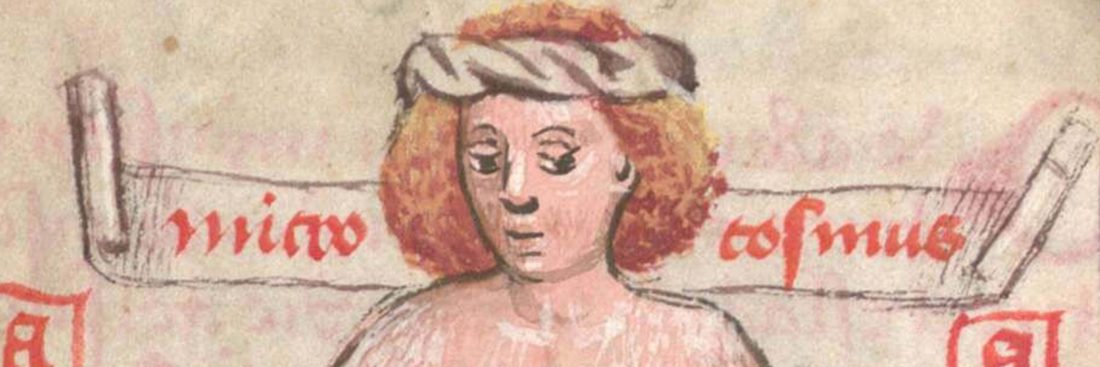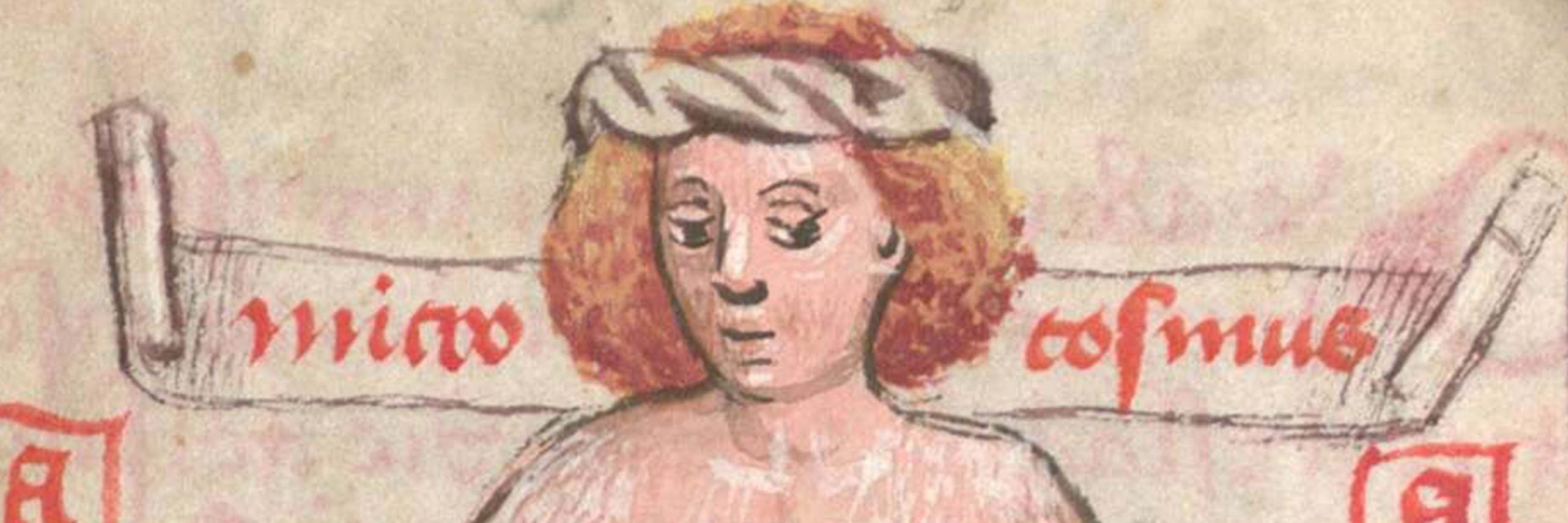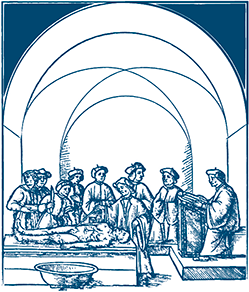Cosmological Resonances of Bodily Fluids


FORMA FLUENS
Histories of the Microcosm
Cosmological Resonances
of Bodily Fluids
Sweat in the Works of
Estêvão Rodrigues De Castro
(1559-1638)
David Mesquita
University of Lisbon
Santorio Fellow

As a growing field of study, early modern medicine still presents many uncharted areas that offer opportunities for research. A notable exploration avenue regards Portuguese medicine and physicians of the sixteenth and seventeenth centuries. Remarkably, despite the presence of influential figures who earned recognition both domestically and on the global stage, this epoch in Portuguese medical history remains a relatively neglected area of study.
Prominent among these medical savants are physicians such as Garcia da Orta (1501-1568), Amato Lusitano (1511-1568), Rodrigo de Castro (c. 1546-1627?), and Zacuto Lusitano (1575-1642), to mention just a few. They collectively played a pivotal role in forging new pathways in the domains of botany and medicine. Garcia da Orta left an enduring legacy with his Colóquios dos Simples (‘Conversations on the Simples’, Goa, 1563) a significant account of medicinal substances from India. Meanwhile, Amato Lusitano is celebrated for his commentaries on Dioscorides (Antwerp 1536; Venice 1553) and his pioneering Curationum medicinalium centuriae VII a compendium of clinical cases that saw multiple editions across various cities, such as the first centuria published in Florence,[1] where he accounts for the azygos vein, which sparked a dispute with Andreas Vesalius (1514-1564). In a different vein, Rodrigo de Castro directed his attention towards women’s healthcare as evidenced in his opus De uniuersa mulierum medicina (Hamburg/Cologne, 1603). Zacuto Lusitano, on the other hand, meticulously documented daily clinical observations, as presented in his De medicorum principum historia (Amsterdam, 1629-1642). Besides their Jewish ascent, what unites these luminaries is the fact they made their name and had an impact beyond their homeland’s borders. A case in point is that of de Castro.
This article primarily aims to draw attention to the significance of Estêvão Rodrigues de Castro (1559-1638) [Figure 1] by looking at his distinctive perspective on the enigmatic phenomenon of sweat as an example of his medico-philosophical thought. During his time, the intricacies of sweat secretion remained an unsolved puzzle, concealed beneath the shroud of scientific inquiry. Castro sits at the borderline of the discoveries advanced decades after his death by Marcello Malpighi (1628-1694) and Nicolaus Steno (1638-1686). With the aid of the microscope, the latter authors were able to pave the way for a novel comprehension of the skin, and its intricate vascular, nervous, and glandular systems. Before that scientific breakthrough, the precise nature of sweat secretion still eluded comprehension, and Castro distinguished himself by offering innovative insights, underpinned by his unique philosophical worldview.
Castro was a Portuguese physician, poet, and philosopher, who became professor of theoretical medicine at Pisa, and archiater to the Grand Duke Cosimo II de’ Medici (1590-1621). He graduated in Philosophy (1585) at the Jesuit Colégio das Artes, in Coimbra, Portugal, and in Medicine at the University of Coimbra (1588). Apart from a few letters, which demonstrate that he practised medicine in Lisbon and was a physician of the Armada in 1606, the period of his life until his departure to France and Italy is not well accounted for.
Castro decided to leave Portugal around 1609, perhaps due to the recrudescence of the Jewish persecution in Portugal.[2] After a short stay in Bordeaux, he arrived in Florence, a city that Cosimo II and Ferdinand II (1610-1670) had made a beacon of clemency, justice, and freedom, as Castro emphatically points out in the Auspicalis oratio (1617) and in the De meteoris microcosmi (1621) [Figure 2]. After settling down, he immediately started teaching private lessons and building a network of contacts, which included fellow countrymen as Rodrigo da Fonseca (1550-1622), who was then Professor of Theoretical Medicine at the University of Pisa.
The turning point in Castro’s career happened in 1616, when he successfully managed to improve Cosimo II’s health, who, since his youth, suffered from stomach and intestine ache. This episode made him closer to the Grand Duke and paved the way to the title of archiater and, shortly after, in 1617, to the position of Professor of Theoretical Medicine at the University of Pisa.
The importance of capturing and retaining the favour and sponsorship of the Medici must have been clear to Castro from the outset. Cosimo I de’ Medici (1519-1574) had previously embraced the patronage of the University of Pisa, and had already put in place a strategy for bringing the great minds of the time to that institution, a policy that had allowed, for instance, the hiring of Giovanni Argenterio (1513-1572), Gabriele Falloppio (1523-1562), or Andreas Vesalius, and was continued by his successors throughout the XVI-XVII centuries. It comes as no surprise, then, that after the death of Cosimo II in 1621 Castro turned to Ferdinand II, his successor, to whom he dedicated his first book and masterwork De meteoris microcosmi (1621). Eventually, he became the Grand Duke’s medicus cubicularius and, later in life, he was granted the title of professore sopraordinario at the University of Pisa, achieving precedence over all other physicians of that same university.
The known sources confirm that Castro was held in high esteem and was a relevant figure until the end of his life. He became involved in lively debates with figures such as Petrus Servius (?-1648), Giulio Guastavini (1560-1636), and Fortunio Liceti (1577-1657), to name but a few. His contacts included Zacuto Lusitano (1575-1642), Giovanni Nardi (c. 1580- c. 1655), Paganino Gaudenzi (1595-1649) and Cassiano dal Pozzo (1588-1657) among others, The letters from Liceti, Geri Bocchineri (?-1650), and Girolamo Bardi (1603-1675) to Galileo contain references to the dispute with the medico portoghese, as Castro was often referred to in Tuscany.[3] All this demonstrates his importance in the Florentine circle and in the European Res publica medicorum et litterarum.
Castro’s reputation gained momentum after he obtained a position at the University of Pisa and started to publish, in what can be seen as an early application of the well-known academic principle of “publish or perish”. He addressed a diversity of topics, from the mutation of diseases (Tractatus de complexu morborum, 1624; Quae ex quibus, 1627), to the utilization of milk serum in medical practice (Tractatus de sero lactis, 1631), or to the field of gynaecological medicine (Tractatus de natura muliebri, 1654 and 1668; a product of his 1634 Pisan lectures), or that of fasting (Tractatus de asitia, 1630), which sparked the dispute with Fortunio Liceti.
David Miguel Soares Mesquita is a PhD Candidate at the Centre for Classical Studies of the University of Lisbon with a project on Estêvão Rodrigues de Castro funded by the Portuguese Foundation for Science and Technology. He holds a BA in Classical Studies from the University of Lisbon (2018), and a double MA from the Universities of Lisbon and Bologna (2021) in Classical Studies and Italian Studies. Between 2018 and 2020 he was a collaborator of Euphrosyne – Revista de Filologia Clássica of Lisbon. In 2019, along with Professor André Simões, he edited the fifth volume of eClassica’s, the journal of the Centre for Classical Studies of the University of Lisbon.
Castro’s most famous book is the De meteoris microcosmi (1621), a foundational work in which he sought to establish the basis of his medical doctrine. By resorting to the Platonic notion of a formative principle, the archetype,[4] Castro argued for the existence of an intrinsic relationship between the Macrocosm (the world) and the Microcosm (the human body) dating back to the moment of creation [Figure 3], and adhered to the idea that, by observing analogous phenomena in the world and in human beings, a physician should be able to draw new arguments and explanations for the affections of the human body. The idea was not entirely new and could be found in the preceding tradition, but Castro gave it special prominence, creating a series of original analogies in support of his medico-philosophical theses.
Therefore, Castro’s treatment of medico-philosophical topics is tied to the conceptual standpoint presented in the primordial De meteoris microcosmi. Many examples can confirm this, one of which relates to the phenomenon of sweat. Whereas the Syntaxis praedictionum medicarum (1661) [Figure 4], a work in medical practice, discusses sweat in the section dedicated to the prognostications of health and death (Praesagia salutis aut mortis), that is, as one of several bodily excretions, like urine or faeces, that played a significant role in indicating the patient’s health condition, the De meteoris microcosmi lays the foundations for a plausible explanation of sweat as a physiologic process per se, given that it remained a conundrum and an originator of bitter disputes among theoretical physicians and natural philosophers.
The conceptual framework presented in the De meteoris microcosmi provides two different kinds of insights in this regard. On the one hand, it shows where to find a key to interpret the variations of temperature, frequency and quantity of liquid retention and expulsion, which includes sweat, by pointing to similar variations in the springs of the macrocosm, where the sequences of events, or chains of causality, are more easily observable; this supports the physician’s use of sweat as a tool for prediction and treatment of the underlying disease.[5] On the other hand, it leads to two hypotheses for the generation of sweat. In one way, sweat might result from the condensation of vapours, in a process comparable to that of the ascent of vapours and subsequent formation of rain in nature;[6] in another way, sweat might be drained from the blood through a process of friction, as if passing through a sieve, given that it is a thin and watery fluid and one of the abundant liquids of the body.[7]
In short, Castro explains bodily functions by resorting to analogies with observable phenomena of the macrocosm, a strategy dependent on theoretical and philosophical considerations brought forward in the De meteoris microcosmi. When his discussion of specific topics, such as that of the physiology of sweat, is analysed, Castro’s standpoint reveals itself as a strategy to make participation in contemporary disputes unavoidable. It also shows that Castro directs his discourse to a varied target audience that includes physicians and philosophers, which shows that the borderline between natural philosophy and medicine needed redefinition.











